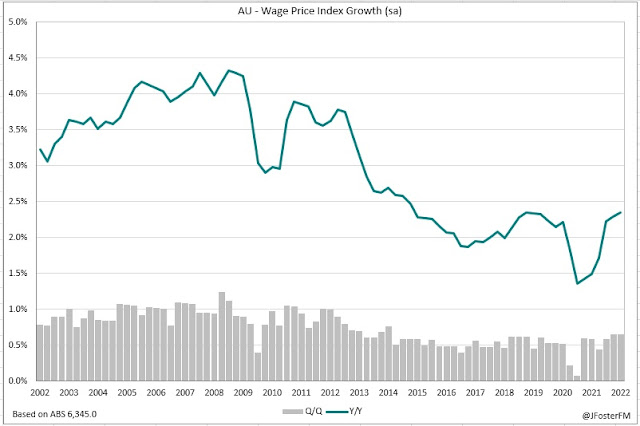Concerns over growth prospects were behind another volatile week for markets as central banks reiterated their focus on addressing high inflation. With equities on the back foot, bonds extended their rally, though Asian markets saw gains in anticipation of an easing of lockdown measures in China and a rate cut from the PBC.
RBA puts its options on the table as the labour market continues to tighten
The RBA's May Board meeting minutes were clearly hawkish, revealing that although it decided to commence its hiking cycle with a 25bps rate increase, a larger hike of 40bps had come under consideration. The least aggressive option it considered was a 15bps rate hike (the forecast of many analysts on the day) but this was seen as inconsistent with the Board's determination that it needed to start withdrawing accommodative monetary policy. With updated economic forecasts prepared by Bank staff showing that inflation was not anticipated to return to the midpoint of the 2-3% target band until the second half of 2024 and that wage pressures would gradually build, the key message in the minutes was that the Board saw the risk that the inflation dynamics could shift "... in an enduring way" if it did not act.
With a potential 40bps rate hike on the table in June, the further tightening in the labour market reported this week has kept market pricing skewed in that direction. The national unemployment rate printed at 3.9% in April, its lowest since 1974, and border measures of underutilistaion in the labour market declined to lows last seen in 2008 (reviewed here). Although monthly employment disappointed expectations lifting by a net 4k, there appears to have been many nuances at play in April, with a strong rise in hours worked (1.3%m/m) indicating activity remains strong.
In contrast to many other advanced economies, strong demand for labour is being met by the supply side, with labour force participation (66.3%) remaining around record highs. Perhaps this is one of the key factors that is keeping wages growth relatively contained, with the Wage Price Index coming in below expectations this week at 0.7%q/q and 2.4%Y/Y in the March quarter. However, as discussed in the review, compositional effects may have muted a stronger underlying wage pulse.
The accumulation of data from the labour market, private sector surveys and the RBA's business liaison points to wages rising more strongly over the back half of the year. Wages growth at the current pace could raise the possibility that the RBA will elect to hike by 25bps rather than 40bps in June. In what looks a finely balanced call, I tend to think the Board may side with 40bps, which would return the cash rate to its pre-pandemic level (0.75%) and be in line with its messaging of withdrawing extraordinary policy stimulus.
Fed to remain on the press
In an interview with the WSJ, Federal Reserve Chair Jerome Powell reiterated the FOMC's intent was to bring down inflation and that it was prepared to lift rates above estimates of neutral into a restrictive range if required. Rate hikes of 50bps at the next couple of meetings remain on the table. Overall, Chair Powell's assessment was that the Fed needed to tighten policy to slow demand in the economy to be in closer alignment with its supply capacity. Although acknowledging the challenges facing the Fed, Chair Powell said he saw there were "plausible paths" to a soft landing, where economic growth moderates but remains positive and inflation comes down from its elevated pace.
ECB hawks align on July hike
Over recent weeks, the messaging from ECB officials has been gradually converging to market pricing for rates to start rising in July. The suggestion from Dutch central bank president Klass Knot this week that rates may need to rise by 50bps in July ratcheted the tone up, even if it appears at odds with the ECB's guidance for gradualism in adjusting policy settings in light of the current uncertainties. Although somewhat dated by the recent remarks, the account of the ECB's April meeting indicated that the Governing Council was becoming increasingly concerned about rising inflation and the risk of it being entrenched, with some members judging that the current monetary policy stance was "...no longer consistent with the inflation outlook". This came as April's euro area inflation readings were finalised this week at 7.4%Y/Y on a headline basis and at 3.5%Y/Y on the core rate.
UK inflation increases pressure on policymakers
Headline inflation in the UK lifted 2ppts to hit 9%Y/Y in April as the very large increase in the household energy price cap flowed through to consumers. Though predominantly driven by the global shock to energy prices, inflation pressures in the UK are broad based as the core rate continued to lift, rising from 5.7% to 6.2%Y/Y.
Media reports detail the pressure the UK government is coming under to provide additional measures to provide cost of living support for low-income households. Meanwhile, Bank of England officials came under scrutiny at this week's appearance before the Treasury Committee over its earlier assessment that supply constraints in the labour market would resolve more quickly than is proving to be the case. With participation remaining well down on pre-Covid levels, the UK unemployment rate was reported by the ONS this week to have declined to 3.7% in March. The tight labour market pushed annual growth in average weekly earnings up to 4.2%, a stronger-than-expected rise.





